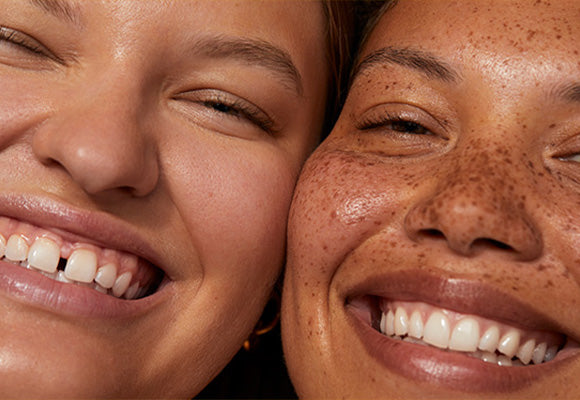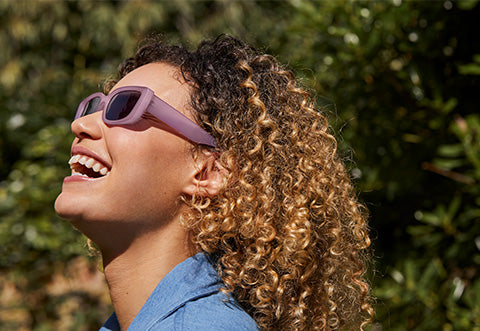The warm weather has arrived! The sun is shining, and we’re all looking forward to spending more time outdoors with family and friends. But how do you keep safe when enjoying this glorious sunshine?
In this article, we talk all things suncare, from what SPF actually means, to making sure you're sun-safe wherever you are.

What does sunscreen do?
First thing’s first, let’s get to grips with what sunscreen actually does. Depending on the SPF and ingredients, sunscreens are used to offer sun protection and help minimise the amount of UVA and UVB rays that reach your skin.
Sun protection is important because UV rays can have a harmful effect on the skin when not protected, leading to burns, discomfort and skin cancer in some cases.
Sunscreen should form part of your everyday sun-protective skincare routine, especially if you have pale or sensitive skin. It also helps when it comes to anti-ageing by preventing damage to the skin, which can make it look older and more wrinkled.
What are UVB & UVA rays?
UVB rays are pretty harmful – they can cause sunburn and play a big part in many skin cancers.
UVA rays cause the type of skin damage that leads to a tan, but also premature ageing and wrinkles.
What about SPF?
So, what does that all mean to you? Well, if you regularly reapply a sunscreen with SPF 30, you’re allowing just 3% of UVB rays to reach your skin. However, if you use one with SPF 50, you’re only allowing 2% of UVB rays – that’s a huge difference between the two!
We'd always recommend using at least SPF 30 on most days to protect your skin from the sun. But if it’s looking like a super sunny day, grab the factor 50!

How do I apply sunscreen on my face?
For start, you should wear sunscreen every day – even when it’s cloudy. It doesn't matter whether you opt for a lotion, mineral-based or spray sunscreen, as long as you use sun protection with a good level of SPF. For acne-prone skin, you might like to look for a non-greasy formula that won't aggravate your skin further.
Always try to keep at least an SPF 15 in your bag or cupboard ready to apply before you leave the house. It might not feel sunny, but your skin will thank you later.
Secondly, don’t just apply protection to your bare arms, face or legs. You should apply it to your whole body, even under clothing for optimum protection. Most UVA and UVB rays can still reach your skin through your clothes.
For hard-to-reach places like your back or the back of your neck, you should always ask someone else to help you to ensure full protection.
How much sunscreen should I apply?
Based on the science-backed and expert advice of dermatologists, you should aim to apply around 2 tablespoons of sun cream over your whole body – or until you see a sheen. For your face, you should aim to use a blob the size of a 20 pence piece to ensure your face is fully protected.
When applying and rubbing in, you don't want to feel like you're pulling on the skin as this could mean you're not applying enough and could result in burning or damage to the skin in neglected areas.
How long after applying sunscreen can I go outside?
For optimal sun protection, you should apply sunscreen around 30 minutes before you plan on going outside. This ensures it has enough time to soak into your skin and protect you from the sun's harmful rays. It will also be less likely to wash off with sweat or other moisture once it has had time to dry a little.

How long after applying sunscreen can I swim?
Apply your sunscreen 20–30 minutes before swimming. Even if you’re using water-resistant sunscreen in the pool or sea, remember to top up as soon as you're dry! That’s because water can reduce the effectiveness of your sunscreen.
Is applying sunscreen once a day enough?
No, sunscreen should be applied multiple times throughout the day. For prolonged protection, you should aim to reapply every 2 hours. This should be increased if you’re sweating excessively or splashing around in the water.
How to apply sunscreen over make-up
Using sun protection doesn't mean you need to go without your other favourite skincare and make-up products. If you're applying sunscreen and moisturiser, you should put your SPF on first and ensure it has time to absorb before using moisturiser. If you're applying sunscreen and make-up, the same rule applies, and you should always aim to add more throughout the day where possible.
Some make-up and moisturiser products have SPF included in their formulas. However, it's always a good idea to use extra underneath as the levels included in other products are usually very minimal and will not offer enough protection.
How long does sunscreen last?
If you’re applying your SPF correctly, you’ll probably use a bottle at least once a year. But, if you discover some unopened, hiding in your cupboards, just remember that your sunscreen should last up to 3 years. After then, it won’t be able to properly protect your skin from harmful UV rays.

If you find an opened bottle, be sure to check the PAO (period-after-opening) symbol on the bottle for more information on how long it lasts.
Does sunscreen stop you from tanning?
Because sunscreen reduces the amount of UVA reaching your skin, it’ll prevent tanning to some extent, depending on your skin type. Tanning is caused by your skin’s natural reaction to inflammation. When inflammation is reduced, so is your tan.
But don’t worry about missing out, you can still achieve a gorgeous glow with a fake tan.
Does sunscreen offer enough protection?
Sunscreen alone is not enough to fully protect you from the sun's harmful rays, but it does a pretty good job. To ensure your skin is completely protected when out in the sunshine, you should also wear a long-sleeved T-shirt, lip balm with SPF and a wide-brimmed hat to protect your face, neck and ears from burning.
The ears and feet are some of the most common places for sunburn to occur and are also the places we miss the most when putting on our sunscreen. Even with a single dose of sunscreen and these additional measures, reapplication throughout the day is still important – especially on days where UV levels are high.

Best time to enjoy the sun
Although we’d love to spend every second of the day outside in the sun, this isn’t always the best idea. To keep your skin healthy, you should try to make the most of the weather before midday, as this is when the sun is at its brightest and hottest. If this can’t be helped, always come prepared with plenty of sun protection and try to find a spot with shade – especially if you’ve got fair skin!
Soothe the burn
Sunburn can still happen, even when you’re super-careful. To keep your skin nourished and feeling healthy, always treat it to an after-sun product, preferably one with soothing aloe vera.
The Skin Cancer Foundation has plenty of advice on how you can treat burns after over-exposure to the sun.
Ready to enjoy the sun safely? Keeping your skin safe 365 days of the year is important and luckily for you, we’ve got plenty of suncare options. From sunscreen for your kids to SPF-infused foundation, it’s time to get prepped for the sun.